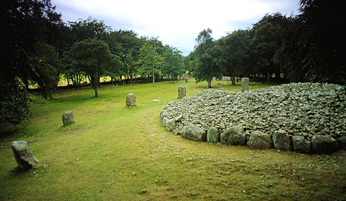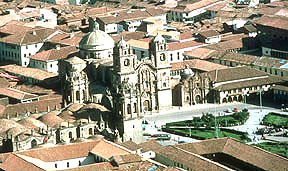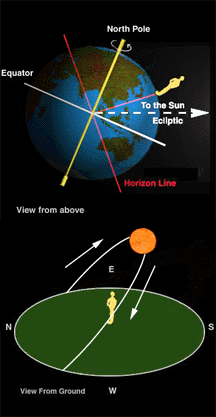A diagram showing how the Sun moves through the sky on the Summer solstice.
Click on image for full size
The Summer Solstice
The summer solstice, which occurs around June 21, is the longest day
of the year! This is because the Sun gets very high in the sky for
people living in places north of the equator like the United States,
Europe, and China. The Sun stays above the
horizon for more than 12 hours on that day.
The diagram to the left shows how the Sun may appear to move through
your sky on the summer solstice, if you live at a latitude of 40° N, around Topeka, Kansas for instance.
The Sun has been climbing higher and higher in the sky since the vernal equinox around March 21. As the Sun
gets higher, and as the days get longer, the northern part of the
Earth warms up - it's summer!
Did you notice that the Sun doesn't go directly over the
person's head?? The Sun only passes directly overhead for people living
very near the equator. Compare this picture to what you would see in
the winter or on an equinox.
You might also be interested in:

On Thursday, June 21, 2001, there will be a total eclipse of the Sun. Only people living in Africa and Madagascar will see the real eclipse. If you don't live in Africa, you can watch the eclipse on NASA
...more
Simple astronomy was probably practiced at Stonehenge over 4,000 years ago. These ancient observers would especially observe the movement of the Sun and Moon across the sky. Stonehenge actually lines up
...more
People have been living in North America for a long, long time. The first people to live there were the Native Americans. They didn't have clocks or calendars so they watched tides, the Sun, the Moon,
...more
Man has always observed the sky. By watching the Sun and Moon, early man could tell what season was coming next. They had to know this to be able to farm and hunt. Archeoastronomy started in the 1960's
...more
The stones of Carnac, France, are very famous because there are a lot of them and because they are so old! The oldest stones found in Carnac are from about 4,500 B.C. That's older than the stones at Stonehenge!
...more
You may have heard of the lake called Loch Ness, where people think they've seen the Loch Ness monster. Near Loch Ness there are three giant stone tombs you may not have heard of...they are called the
...more
Cuzco is a city in Peru. It was the capital of the ancient Inca Empire. In ancient times, Cuzco was the center of the Inca road network which was made up of about 40,000 kilometers (25,000 miles) of roads
...more















